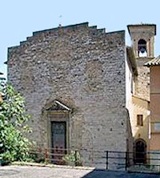
A church on this site that was dedicated to SS Simon and Jude (SS Simone e Guida) was documented as a parish church in 1285. In 1296, Bishop Bulgaro Montemelini gave the church to a community of Carmelites, who moved here from their earlier settlement at Santa Maria della Valle. They re-dedicated the church to St Simon Stock, [the Englishman who had been their Minister General in the period 1247-65], and built the adjacent convent in Via Abruzzo to the right.
The Carmelites rebuilt the church in 1377 using stone from the demolished fortress at Porta Sant’ Antonio (part of the Fortezza di Porta Sole).
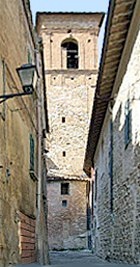
The Carmelites were expelled in 1860:
-
✴The convent, which extends along Via Abruzzo and behind it along Via XIV Settembre, re-opened in 1861 as l’Asilo della Santa Croce, the first kindergarten in Umbria, on the first anniversary of the liberation of the city from papal forces. It still operates as the Scuola dell’ Infanzia Santa Croce.
-
✴The church [which now belongs to the Knights of the Holy Sepulcher of Jerusalem] is usually closed.
Interior of the Church
The interior was transformed in 1854-6, when a fresco cycle (ca. 1630) by Anton Maria Fabrizi (below) was mostly destroyed.
Gonfalon (15th century)
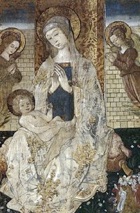
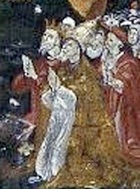
-
✴the Emperor Henry VI;
-
✴Pope Innocent III; and
-
✴St Albert of Jerusalem, the Patriarch of Jerusalem who was claimed to have given the Carmelites their rule shortly before his death in 1214.
This choice of characters was probably motivated by an attempt to prove that the Carmelite Order was the oldest of the mendicant orders.
St Albert (1607)
The altarpiece by Avanzino Nucci [is signed and dated by inscription, and was painted in Rome]
Allegory of Chastity (1630)
This fresco in the vault of the nave by Anton Maria Fabrizi was preserved within the later pictorial cycle by Mariano Piervittori (below), as a record of Fabrizi’s work in the church.
Frescoes (1855-6)
The fresco decoration of the church was commissioned from Mariano Piervittori. The scenes include:
-
✴two on the walls:
-
•the angel of Jerusalem; and
-
•St Albert of Jerusalem; and
-
✴in the vault of the nave:
-
•St Simon stock receives a sash from the Virgin; and
-
•five allegories of Virtues (with a sixth by Anton Maria Fabrizi mentioned above).
Convent
The frescoes (17th century) in the ex-convent have been recently restored. [Are they accessible ?? The entrance is in Via XIV Settembre.]
Some of the work in the convent by Anton Maria Fabrizi survives, including:
-
✴a fine fresco (1630) of the Baptism of Christ, which is signed and dated by inscription, on the ceiling of what was the Stanza del Vice Priore; and
-
✴five lunettes depicting scenes from the life of the prophet Elijah in what was the refectory.
Art from the Church
Triptych (ca. 1365)
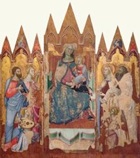
The inclusion of the prophet Elijah (see below) suggests that the work was commissioned for the church. (Elijah was regarded as the founder of the Carmelites, and his representation here as a saint wearing the Carmelite habit followed the precedent of the important polyptych (1329) that Pietro Lorenzetti had painted for the Carmelites of Siena). The Perugia triptych is usually dated to the 1360s on stylistic grounds, although it might have been commissioned after the rebuilding of the church in 1377. There is no record of the artist’s presence in Perugia, and it could have been painted in Siena.
The main panels in this triptych depict:
-
✴the Madonna and Child enthroned;
-
✴an Apostle, St Catherine of Alexandria and a kneeling angel on the left; and
-
✴St Mary Magdalene, Elijah and a kneeling angel on the right.
There are three gables over each of the panels, although the content of those over the central panel has been lost. The other gables depict:
-
✴the Archangel Gabriel flanked by angels (on the left); and
-
✴the Virgin Annunciate flanked by angels (on the right).
Madonna dell’ Orchestra (ca. 1450)
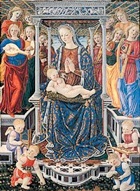
The gallery notes suggest that the altarpiece was originally in the friars’ church. Fabio Marcelli (see the page on the artist) has suggested that it might have been the fruit of the link between Giovanni Boccati and the scholar Tommaso Pontano, both of whom moved to Perugia from Camerino in the 1440s. Tommaso Pontano formed an association of lecturers from the Facoltà delle Arti of the University of Perugia in 1441 that originally met in the church of Santa Maria del Mercato. When this church was demolished in 1545, the association moved to San Simone del Carmine and it is possible that the Madonna dell’ Orchestra moved with them.
The altarpiece depicts the Madonna and Child enthroned, with an angelic orchestra. The throne is set in a meadow, and two angels kneel at its base to pick flowers. A goldfinch seems to peck the finger of the baby Jesus: the goldfinch is a symbol of the Passion because it feeds among thorns.
Holy Family (1520 or 1522?)
This panel, which came from the high altar, is attributed to Pompeo d' Anselmo and Domenico Alfani on the basis of an inscription that is not easy to interpret. This inscription also dates the panel to 1520 or 1522. The design of the central figure group is taken from the sketch (ca. 1507) that Raphael sent to Domenico Alfani that is now in the Musée des Beaux Arts, Lille.
The panel was removed from its altar in 1813 for dispatch to Rome (probably because it was then attributed to Perugino). However, it was subsequently decided that it should stay in the church, and it was re-installed early in the following year. It entered the Galleria Nazionale in 1863 and now in deposit there.
The altarpiece depicts the Virgin seated in a landscape. The standing baby Jesus leans across her lap to take a pomegranate from St Joseph, who is seated nearby. The young St John the Baptist draws the viewer's attention to this act, which foreshadows the Passion. The Virgin's parents, SS Anne and Joachim stand to the sides. Putti play in the clouds, below the Holy Spirit represented as a dove.



